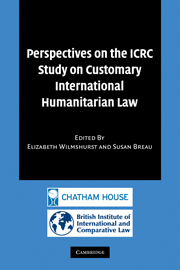Book contents
- Frontmatter
- Contents
- Preface
- List of contributors
- Table of cases
- Table of treaties and other instruments
- Abbreviations
- Part 1 Setting the scene: Theoretical perspectives on international law in the ICRC Study
- Part 2 The status of conflict and combatants: The ICRC Study
- Part 3 Commentary on selected Rules from the ICRC Study
- 6 The law of targeting
- 7 Protected persons and objects
- 8 Natural environment
- 9 Specific methods of warfare
- 10 Weapons, means and methods of warfare
- 11 Fundamental guarantees
- 12 Status and treatment of prisoners of war and other persons deprived of their liberty
- 13 Displacement and displaced persons
- 14 Implementation and compliance
- 15 War crimes
- Part 4 Conclusions
- Index
8 - Natural environment
Published online by Cambridge University Press: 09 July 2009
- Frontmatter
- Contents
- Preface
- List of contributors
- Table of cases
- Table of treaties and other instruments
- Abbreviations
- Part 1 Setting the scene: Theoretical perspectives on international law in the ICRC Study
- Part 2 The status of conflict and combatants: The ICRC Study
- Part 3 Commentary on selected Rules from the ICRC Study
- 6 The law of targeting
- 7 Protected persons and objects
- 8 Natural environment
- 9 Specific methods of warfare
- 10 Weapons, means and methods of warfare
- 11 Fundamental guarantees
- 12 Status and treatment of prisoners of war and other persons deprived of their liberty
- 13 Displacement and displaced persons
- 14 Implementation and compliance
- 15 War crimes
- Part 4 Conclusions
- Index
Summary
Introduction
In 1977 two provisions were adopted in Additional Protocol I that had as their focus the protection of the natural environment. Recognised as having no basis in existing customary law, the two provisions were viewed as new additions to the law governing international armed conflict. While similar provisions were discussed for Additional Protocol II, these did not appear in the final adopted text. The objective of the two new provisions in Additional Protocol I was the absolute prohibition of environmental damage beyond a specific threshold. Consequently, Article 35(3) prohibits the use of methods or means of warfare intended or expected to cause widespread, long-term and severe damage to the natural environment, whether the harm is direct or collateral. Positioned in the ‘Basic Rules’ of Part III of Additional Protocol I, concerning ‘Means and Methods of Warfare’, the environmental protection provisions are located alongside the established customary principle of unnecessary suffering. Cementing the prima facie civilian status of the natural environment, a further three aspects of environmental protection are provided in Article 55:
a general obligation of environmental awareness in the conduct of warfare,
a specific prohibition on means and methods of warfare causing widespread, long-term and severe environmental damage and thereby prejudicing the health or survival of a population, and
a prohibition on environmental reprisals.
- Type
- Chapter
- Information
- Publisher: Cambridge University PressPrint publication year: 2007



